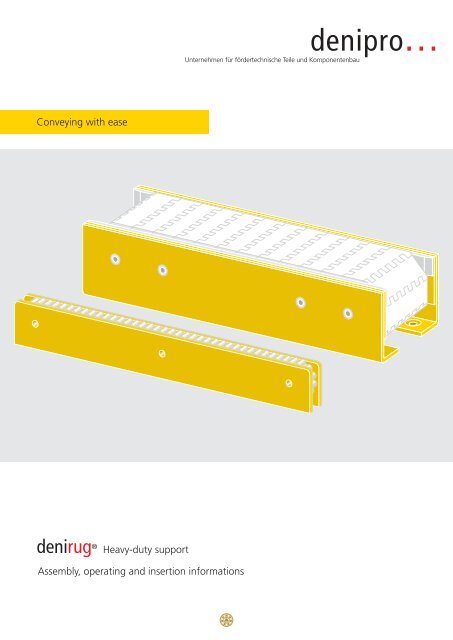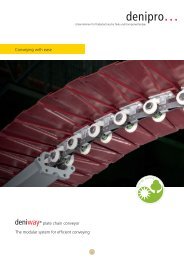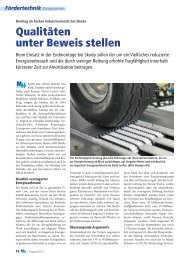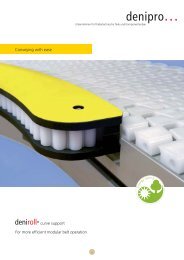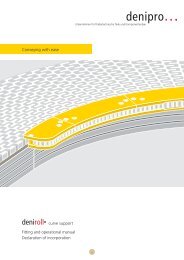Conveying with ease Assembly, operating and insertion - Denipro
Conveying with ease Assembly, operating and insertion - Denipro
Conveying with ease Assembly, operating and insertion - Denipro
Create successful ePaper yourself
Turn your PDF publications into a flip-book with our unique Google optimized e-Paper software.
<strong>Conveying</strong> <strong>with</strong> <strong>ease</strong><br />
denirug ® Heavy-duty support<br />
<strong>Assembly</strong>, <strong>operating</strong> <strong>and</strong> <strong>insertion</strong> informations
1 General<br />
All these instructions have only been drawn up by assembly,<br />
operational <strong>and</strong> maintenance personnel that are technically<br />
qualifi ed. Before assembling denirug ® heavy-duty supports<br />
<strong>and</strong> <strong>operating</strong> the conveyor, pl<strong>ease</strong> read these informations<br />
carefully. This document contains safety instructions.<br />
Two types of denirug ® heavy-duty supports are supplied:<br />
– the basic denirug ® element;<br />
– the denirug ® module.<br />
These informations deal <strong>with</strong> both types. The principle stays<br />
the same, but technical progress can mean changes in the<br />
design.<br />
2 Safety<br />
2.1 Proper usage<br />
denirug ® heavy-duty supports are roller elements for vertical<br />
support of heavy loads in conveyors. The supports can be<br />
retrofi tted in existing conveyors. Two types are supplied for<br />
different purposes:<br />
Basic denirug ® elements are for rolling support of fabric-based<br />
conveyor belts <strong>and</strong> modular belts <strong>with</strong> a suitable underside.<br />
denirug ® modules are modular belt sections on rollers for<br />
fl exible support of heavy loads <strong>with</strong> a large contact area<br />
(unit goods, containers, pallets, skids etc).<br />
2.2 General safety instructions<br />
denirug ® heavy-duty supports are state of the art <strong>and</strong> comply<br />
<strong>with</strong> recognised safety regulations. If used improperly, risks<br />
can occur. denirug ® heavy-duty supports may only be used<br />
when in perfect condition. To avoid risk to the user or other<br />
people <strong>and</strong> prevent damage, they may only be assembled,<br />
maintained <strong>and</strong> operated by specially trained personnel.<br />
Important instructions in the text appear as follows:<br />
Caution<br />
In this case, procedures must be fully complied <strong>with</strong> to avoid<br />
damaging the machinery.<br />
Warning<br />
In this case, procedures must be fully complied <strong>with</strong> to avoid<br />
damaging the machinery <strong>and</strong>/or putting the user or other<br />
persons at risk.<br />
All work <strong>with</strong> <strong>and</strong> operation of denirug ® heavy-duty supports<br />
must be in compliance <strong>with</strong>:<br />
– these regulations<br />
– the conveyor's technical instructions<br />
– all relevant statutory regulations <strong>and</strong> safety regulations.<br />
Warning<br />
Before carrying out any assembly, maintenance <strong>and</strong><br />
repairs, the conveyor drive’s master switch must be<br />
switched off <strong>and</strong> prevented from being switched on<br />
again. Where gravity conveyors are concerned,<br />
the area must be cordoned off appropriately <strong>and</strong><br />
monitored.<br />
DG_bma_EN_11.10<br />
2
3 How it works/types<br />
3.1 basic denirug ® element<br />
➌<br />
1 Goods conveyed<br />
2 Supported conveyor belt (here modular belt)<br />
3 Basic denirug ® element <strong>with</strong> roller belt (4)<br />
4 Operation/maintenance/servicing<br />
4.1 Operating conditions<br />
denirug ® heavy-duty supports are not explosion protected<br />
<strong>and</strong> are operated in the following ambient conditions:<br />
– ambient temperature according to information<br />
on the data sheet;<br />
– normal atmosphere (no oil or gas atmospheres,<br />
no corrosive atmospheric components).<br />
There is no guarantee that the support will function properly<br />
if used in temperatures below or above those specifi ed.<br />
In certain conditions, static build-up can occur when using<br />
denirug ® heavy-duty supports. In environments <strong>with</strong> explosion<br />
risks, the appropriate regulations for components used<br />
in such environments must be taken into account.<br />
4.2 Maintenance<br />
denirug ® heavy-duty supports require no maintenance<br />
<strong>and</strong> no lubrication must be applied at all.<br />
3 DG_bma_EN_11.10<br />
➊<br />
➍<br />
➋<br />
3.2 denirug ® module<br />
➋<br />
➌<br />
1 Goods conveyed<br />
2 denirug ® module<br />
<strong>with</strong> plastic modular belt (3)<br />
<strong>and</strong> integrated denirug ® element (4)<br />
4.3 Servicing<br />
➍<br />
denirug ® heavy-duty supports should be looked at <strong>and</strong><br />
checked that they operate smoothly at regular intervals,<br />
e.g. at the regular maintenance dates.<br />
Jolting belts are probably the result of soiling. Loose particles<br />
can be removed by careful air cleaning. Dirt that has stuck<br />
can be removed <strong>with</strong> st<strong>and</strong>ard, mild cleaning agents.<br />
If damage has occurred, or there are clear signs of wear<br />
<strong>and</strong> tear, denirug ® elements must be exchanged. In the<br />
case of denirug ® modules, the roller elements on the inside<br />
(middle unit) can be completely exchanged.<br />
➊
5 <strong>Assembly</strong> instructions<br />
Pl<strong>ease</strong> note:<br />
Geometrically, the conveying line must be correctly<br />
positioned for the denirug ® heavy-duty support to<br />
function reliably.<br />
denirug ® heavy-duty supports can be assembled in different<br />
ways (see sections 5.1 <strong>and</strong> 5.2). The following principles must<br />
be complied <strong>with</strong>:<br />
– Each denirug ® heavy-duty support is affi xed separately.<br />
– In accordance <strong>with</strong> the subsequent load, the base must<br />
be able to bear loads, horizontal <strong>and</strong> fl at. In the case<br />
of gravity conveying, minimum inclination is required<br />
<strong>and</strong> must be established by carrying out tests.<br />
– The distribution of the denirug ® heavy-duty supports is<br />
carefully planned separately according to the subsequent<br />
load distribution. The loads stated in the data sheets must<br />
not be exceeded. Support is often advisable in several<br />
tracks, where the heavy-duty supports are fi tted behind<br />
one another.<br />
– The supports must be fi tted precisely in the conveying<br />
direction. If there are several tracks, ensure they are<br />
parallel.<br />
– The supports are fi tted at the same height.<br />
Warning<br />
Before carrying out any assembly, maintenance<br />
<strong>and</strong> repairs, the conveyor drive’s master switch<br />
must be switched off <strong>and</strong> prevented from being<br />
switched on again.<br />
Where gravity conveyors are concerned,<br />
the area must be cordoned off appropriately<br />
<strong>and</strong> monitored.<br />
5.1 basic denirug ® element<br />
Basic denirug ® elements have drill holes (ø 12.5 mm) right<br />
across the body which allow different affi xation methods.<br />
– They can be affi xed <strong>with</strong> brackets on the base (fi g. 5. 1.1)<br />
– They can be affi xed <strong>with</strong> each other to form extensive<br />
structures, using threaded rods of appropriate sizes (1) <strong>and</strong><br />
tube sections (2). Sliding strips (3) are integrated directly<br />
into the structure if required (fi g. 5.1.2).<br />
Furthermore, basic denirug ® elements (for example in the case<br />
of slider beds) can simply be placed in the recesses. The<br />
support from below must be provided by a second base<br />
(fi g.5.1.3).<br />
Fig. 5.1.1<br />
Fig. 5.1.2<br />
Fig. 5.1.3<br />
➊<br />
➋<br />
➌<br />
DG_bma_EN_11.10<br />
4
5.2 denirug ® module<br />
denirug ® modules have holes to affi x them (ø 9 mm) <strong>and</strong> can<br />
be screwed directly to or fully bonded <strong>with</strong> the base.<br />
5.2.1 Screw mounting<br />
– Make drill holes on the base according to the module’s<br />
hole pattern.<br />
– Use an awl to push out a hinge pin on the modular belt;<br />
take off the modular belt (fi g. 5. 2.1-1).<br />
– Affi x denirug ® module securely <strong>with</strong> dowels/braces <strong>and</strong><br />
screws (fi g. 5.2.1-2)<br />
– Attach modular belt <strong>and</strong> close <strong>with</strong> the hinge pin.<br />
Pl<strong>ease</strong> note: As an alternative to removing the modular belt,<br />
the entire roller belt element <strong>with</strong> the modular belt can be<br />
taken out of the body. To do so, unscrew the counter-sunk<br />
head screws on the sides.<br />
5.2.2 Bonded assembly<br />
Double-sided acrylic foam tape (2 mm thick) is used in<br />
bonded assembly.<br />
– Mark the assembly position on the base.<br />
– Prepare the areas to be bonded properly <strong>and</strong> stick the<br />
module accurately onto the base.<br />
Pl<strong>ease</strong> note: As regards the optionally supplied adhesive tape<br />
the bond will hold after 20 minutes (85% of the level of the<br />
fi nal bond). After 72 hours the adhesive has hardened<br />
completely.<br />
5 DG_bma_EN_11.10<br />
Fig. 5.2.1-1<br />
Fig. 5.2.1-2<br />
➋<br />
Fig. 5.2.3<br />
5.2.3 Assembling accessories<br />
Screw the side guidance plates (1) <strong>and</strong> end plates (2)<br />
directly onto the already affi xed denirug ® module<br />
(screws are included).<br />
Feed ramps (3) are screwed directly in front of the module<br />
on the base (affi xation holes ø 12 mm).<br />
➊<br />
➌
5.1 Declaration of incorporation for incomplete machinery · Basic denirug ® element<br />
<strong>Assembly</strong> declaration in line <strong>with</strong> EC machine directive 2006/42/EC, appendix II b<br />
Incomplete machine: Basic denirug ® element;<br />
Element to provide rolling support of fabric-based conveyor<br />
<strong>and</strong> modular belts.<br />
Designation: Basic denirug ® element<br />
Manufacturer: <strong>Denipro</strong> AG<br />
Tannenwiesenstrasse 5<br />
CH-8570 Weinfelden<br />
Person authorised to compile the<br />
assembly <strong>and</strong> <strong>operating</strong> instructions: Marco de Angelis<br />
<strong>Denipro</strong> AG<br />
Tannenwiesenstrasse 5<br />
CH-8570 Weinfelden<br />
The manufacturer declares that the above-mentioned incomplete machine complies <strong>with</strong> the basic health <strong>and</strong> safety requirements of<br />
the EC machine directive 2006/42/EC, appendix 1.<br />
The technical documentation of this incomplete machine was drawn up in accordance <strong>with</strong> the EC machine directive 2006/42/EC,<br />
appendix VII part B.<br />
The manufacturer undertakes to forward these technical documents to government bodies if good reasons are given.<br />
Commissioning of the incomplete machine is prohibited until the incomplete machine is inserted into a machine <strong>and</strong> such machine<br />
complies <strong>with</strong> the regulations set out in the EC machine directive <strong>and</strong> an EC declaration of compliance in accordance <strong>with</strong> appendix II A<br />
has been obtained.<br />
<strong>Denipro</strong> AG<br />
CH-8570 Weinfelden, 30.10.2010<br />
Marco de Angelis<br />
(Head of development)<br />
DG_bma_EN_11.10<br />
6
5.2 Declaration of incorporation for incomplete machinery · denirug ® module<br />
<strong>Assembly</strong> declaration in line <strong>with</strong> EC machine directive 2006/42/EC, appendix II b<br />
Incomplete machine: denirug ® module;<br />
Modular belt section on rollers for linear, fl exible, vertical support of heavy loads<br />
<strong>with</strong> large contact areas (unit goods, containers, palettes, skids etc).<br />
Designation: denirug ® module<br />
Manufacturer: <strong>Denipro</strong> AG<br />
Tannenwiesenstrasse 5<br />
CH-8570 Weinfelden<br />
Person authorised to compile the<br />
assembly <strong>and</strong> <strong>operating</strong> instructions: Marco de Angelis<br />
<strong>Denipro</strong> AG<br />
Tannenwiesenstrasse 5<br />
CH-8570 Weinfelden<br />
The manufacturer declares that the above-mentioned incomplete machine complies <strong>with</strong> the basic health <strong>and</strong> safety requirements of<br />
the EC machine directive 2006/42/EC, appendix 1.<br />
The technical documentation of this incomplete machine was drawn up in accordance <strong>with</strong> the EC machine directive 2006/42/EC,<br />
appendix VII part B.<br />
The manufacturer undertakes to forward these technical documents to government bodies if good reasons are given.<br />
Commissioning of the incomplete machine is prohibited until the incomplete machine is inserted into a machine <strong>and</strong> such machine<br />
complies <strong>with</strong> the regulations set out in the EC machine directive <strong>and</strong> an EC declaration of compliance in accordance <strong>with</strong> appendix II A<br />
has been obtained.<br />
<strong>Denipro</strong> AG<br />
CH-8570 Weinfelden, 30.10.2010<br />
Marco de Angelis<br />
(Head of development)<br />
7 DG_bma_EN_11.10
<strong>Denipro</strong> AG<br />
Tannenwiesenstrasse 5<br />
CH-8570 Weinfelden<br />
Phone +41 71 626 47 47<br />
Fax +41 71 626 48 48<br />
info@denipro.com<br />
www.denipro.com<br />
DG_bma_EN_0018_11.10


